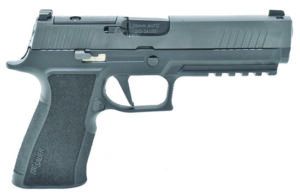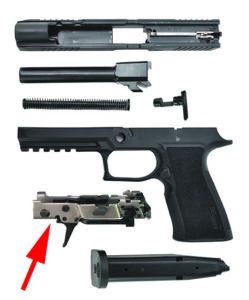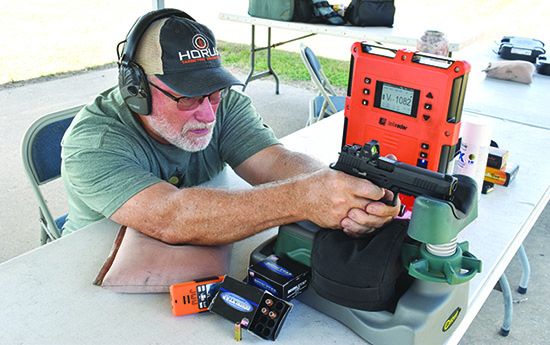It has become obvious that the shooting public recognizes the utility of the 10mm Automatic round as a self-protection cartridge. The 10mm Auto — we’ve actually heard it described as a “rimless 41 Magnum” — requires strong-framed guns, and manufacturers are responding. Gun builders keep designing new pistols for the cartridge, so we’ll keep reviewing them for you. With that in mind, we selected two 10mm Auto striker-fired pistols that come configured for the easy addition of optics.
Our first sample is the Glock G40 MOS. Sporting a 6-inch barrel and a muzzle-heavy design, the G40 MOS is designed to wring the most out of this cartridge while helping tame muzzle flip. It uses a 4th Generation large frame that can be sized up to fit the biggest bear-paw-sized hands.

Our second test piece is the new SIG Sauer P320 X10. Less than a quarter-inch longer than a full-sized 9mm P320, the X10 is also heavier and leaves the balance point well forward. Amazingly, the larger-caliber pistol fits in our existing P320 9mm gear.
In addition to bench testing, we also wanted to test practical accuracy, so we did two additional tests. The first used 3-by-5-inch stickies attached to paper targets 9 yards downrange. We recorded first-shot times as well as split times and totals using 180-grain ammo. The second was a single shot on an A Zone (5-by-11-inch) plate at 25 yards. Start position on both drills was from low ready. We tested using three different types of ammunition. The first was a 155-grain XTP from Hornady. Second was a 180-grain full-metal-jacket round from Armscor. Last was 200-grain Controlled Expansion ammo from Double Tap.
We wanted to test these two pistols for capabilities in self-defense as well as hunting situations and chose the Trijicon RMR with a 3.25-MOA dot as an optic. Well known for its durability, this sight is also light (1.2 ounces with the battery) and has an expected battery life of two years in typical use. Our LED sample was self-adjusting. Just point and shoot, so we did.
SIG Sauer P320 X5-10-BXR3-R2 10mm Auto
$800
GUN TESTS GRADE: A-
Somehow, SIG Sauer managed to make a larger caliber work in a frame that fits your standard-sized SIG holsters — no big hands required.

| Action Type | Semi-auto, striker fired |
| Overall Length | 8.5 in. |
| Overall Height | 5.3 in. |
| Maximum Width | 1.367 in. |
| Weight Unloaded | 1.9 lbs. |
| Weight Loaded | 2.7 lbs. |
| Slide Material | Stainless steel |
| Slide Retraction Effort | 17.4 lbs. |
| Receiver Material | Polymer |
| Finish | Nitron |
| Front Strap Height | 2.4 in. |
| Back Strap Height | 3.5 in. |
| Barrel Length | 5.0 in. |
| Grip Thickness (Maximum) | 1.295 in. |
| Grip Circumference | 5.5 in. |
| Magazines | Two 15- round blue |
| Rear Sight | Two-dot night sight |
| Front Sight | One-dot night sight |
| Sight Radius | 6.75 in. |
| Trigger Pull Weight | 3.8 lbs. |
| Trigger Span | 2.8 in. |
| Safety | Firing pin block |
| Warranty | Limited lifetime |
| Telephone | (603) 610-3000 |
| Website | SIGSauer.com |
| Made In | USA |
Why do we care so much about grip sizes? People who can palm a basketball don’t worry about large grips, though they are going to have real issues with, say, a pocket-sized 380. We have three 200+pounders in the Houston test group. One has long fingers, and two have big hands with average finger length. Like it or not, those dimensions guide our firearm purchases. The goal is to find pistols that will allow us to place it in our hand with the slide lined up with our arm and still be able to get enough finger on the trigger to press it straight to the rear. If the grip is too large or too small, the trigger finger will either hook or push the trigger to one side. This frequently means that the sights are no longer aligned when the pistol fires, and that defeats the purpose of the entire exercise. The two other members of our group are petite ladies for whom grip size can be even more problematic.
Luckily for us, handgun manufacturers are now showing that they are not only aware of the issue but are willing to do something about it. We’ve been able to change stocks on revolvers for decades, but now we have choices on our semi-autos. Witness all of the gun makers that ship different grip inserts with their pistols. Springfield Armory, Glock, Smith & Wesson, FN and more include easily changed inserts that can vary palm size and trigger reach requirements. SIG Sauer and the just-announced Springfield Armory Echelon take this concept a step further. Both offer fire-control groups that are assembled as a single unit cradled in a polymer shell. The polymer shell is produced in small to large sizes that are easily switched out to fit different hand sizes. Custom fitting to a hand is now simple and affordable.
The new SIG X10 10mm pistol we were testing is built for the same system, though we only found the medium-grip modules available as of this writing. We hope there are more to come. Still, they managed to do something with the medium grip we didn’t expect. There are internal differences between the X10 and the standard P320 grips, of course — they are for two very different cartridges and different magazines. But the outside dimensions are almost the same. The dust cover was a little longer, and the magwell was larger on the X10, but we could fit the X10 into existing P320 holsters. The grip width and circumference are virtually the same as a P320X Carry grip module we had in house. SIG has essentially managed to engineer a 10mm cartridge into a 9mm platform, without changing how big the pistol feels in the hand. Bravo.

The grip modules may be very similar, but there are obvious differences between the P320 9mm and the 10mm X10 versions. To start, the slide is a good bit heavier for the 10mm. Again, outside dimensions haven’t really changed, so we looked inside. The walls of the slide were thicker than their 9mm brother, pushing the weight and balance farther forward. The X10 uses a full 5-inch barrel and a heavy flat-wire spring, though slide retraction effort required was only a bit more than 17 pounds, a good bit lighter than many of the 10mm 1911s we’ve seen. Lockup is the same tilting-barrel design; extractors are the same. We even swapped out the Fire Control Units, and they seem to be the same. Full disclosure: We substituted the parts in different guns where everything appeared to operate properly, but we didn’t have a chance to fire them that way, so don’t assume they will work properly.
The X10 comes already machined for an optical sight as many other modern pistols are now, not that they are required. The BXR3 version we tested ships with good night sights. The rear has two dots. Subdued in the light, they don’t distract daytime shooting, but they show up well at night. The front also has a tritium vial insert with a bright-green border that’s very visible in the daylight. We’ve preached against three-dot sights and the potential confusion they can cause. One good bright dot is a different matter altogether, and we like these. SIG makes sight sets that are suppressor height and that can co-witness through the window of the red dot. These do not. The rear sight stays on, then when the dot is mounted, it is below the rear deck of the RMR. We were informed by SIG that the X10 is machined for a SIG Romeo 2 sight or, with a sealing plate, the Trijicon RMR/SRO sight. Once again, we rant a bit. SIG and Trijicon both make outstanding sights, but why do the pistols and sights not work together? If people didn’t like different pistols and different sights, why are there so many options? We repeat our request for more universal mounting arrangements.
Elsewhere, SIG stayed with the expected position of controls on the outside. The slide release is ambidextrous. The magazine catch is one-sided but reversible, as the shooter chooses. The takedown lever is left side only. The trigger is flat-faced and releases close to the desired 90-degree angle. Total movement including take up and overtravel is about 0.3 inch, with the actual break being smooth and clean. The grip panel is textured on most of the area actually touched by the user, with the exception being that around the web of the hand. It is aggressive enough to help maintain a solid grip without being overly abrasive.
The SIG X10 has a 5-inch barrel versus the 6-incher on the G40, but only weighs about 2 ounces less. Though less so than the G40, the X10 was muzzle heavy and felt different than the standard P320 in the hand. We felt the X10 recoiled more than the Glock, but it cycled more quickly, bringing the muzzle down out of recoil sooner, allowing us to make faster follow-up shots. Split times (time elapsed between shots) were about 0.1 second less for the X10 than for the Glock and total times about 0.2 second less. Only you can decide if that is a deal breaker or not.
Overall, the SIG was a bit less accurate, averaging 3.17 inches across all groups versus 2.32 inches for the Glock 40. Much of the delta was with the SIG doing even worse than the Glock with the Armscor ammo. Again, the Armscor 180s performed extremely well in our last 10mm test. These two guns just did not like it. That is why we test. The best performer was the Doubletap 200-grain Controlled Expansion round, averaging 2.36 inches for the five-shot groups at 30 yards. The difference in barrel length gave a slight edge to the Glock, as can be seen in the Range Data chart.
Our Team Said: Both pistols took a half-letter hit on their grades due to limitations of the optical mounting systems. Both were accurate, with the Glock holding a slight advantage. Both were easy to operate quickly, with the overall speed advantage going to the SIG, in our opinion. Both functioned perfectly over several hundred rounds. Both pistols retail for about the same price point. We’re going to call this one a draw. If you’re a Glock shooter already, you’ll like the G40 more, we believe. If you shoot SIGs, go with that one. If you’re agnostic as to platform, rent them both at a local range and see which one you prefer.
| RANGE DATA | ||
| Hornady Custom 155-grain XTP JHP | SIG Sauer P320 X10 | Glock Model 40 |
| Average Velocity | 1409 fps | 1454 fps |
| Muzzle Energy | 683 ft.-lbs. | 727 ft.-lbs. |
| Average Group | 2.50 in. | 1.63 in. |
| Best Group | 1.59 in. | 1.45 in. |
| Armscor USA 180-grain FMJ | SIG Sauer P320 X10 | Glock Model 40 |
| Average Velocity | 1110 fps | 1133 fps |
| Muzzle Energy | 492 ft.-lbs. | 513 ft.-lbs. |
| Average Group | 4.66 in. | 3.71 in. |
| Best Group | 4.06 in. | 3.01 in. |
| Doubletap 200-grain JHP | SIG Sauer P320 X10 | Glock Model 40 |
| Average Velocity | 1081 fps | 1124 fps |
| Muzzle Energy | 520 ft.-lbs. | 561 ft.-lbs. |
| Average Group | 2.36 in. | 1.63 in. |
| Best Group | 2.20 in. | 0.98 in. |
We tested at American Shooting Centers (AmericanShootingCenters.com) in Houston. We used a LabRadar chronograph (MyLabRadar.com, $559) to determine muzzle velocities. We fired bench-accuracy groups from a well-sandbagged Caldwell Pistol Rest from MidwayUSA (MidwayUSA.com), aided by a mini-DRC Fortune Cookie bag from Wiebad.com. Averages reflect five-shot groups at 30 yards.
| DRILL NO. 1 DATA | |
| Pistol | Single Shot Average |
| SIG P320 X10 | 1.268 |
| Glock 40 | 1.201 |
Process: Fire one shot from low ready at A Zone target (5-by-11 inches) placed at 25 yards. Numbers are averages for eight repetitions. Times are in seconds.
| DRILL NO. 2 DATA | |||
| Pistol | 1st Shot | Split Average | Total Time |
| SIG P320 X10 | 1.245 | 0.486 | 2.218 |
| Glock 40 | 1.265 | 0.58 | 2.425 |
Process: Fire three shots from low ready at a 3-by-5-inch target at 9 yards. Numbers are averages for four repetitions. Times are in seconds.
Written by Joe Woolley, using evaluations from Gun Tests Team members. Photographs by Joe Woolley and Roger Eckstine. GT




























